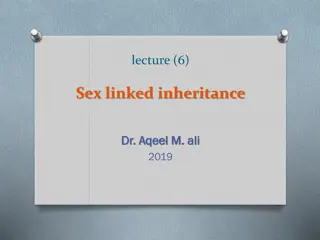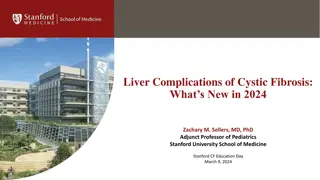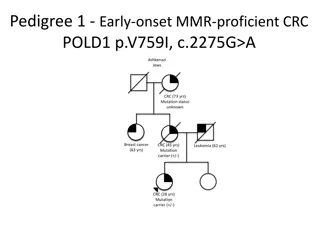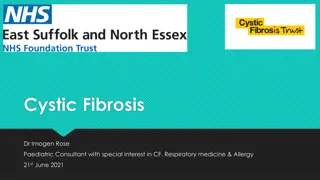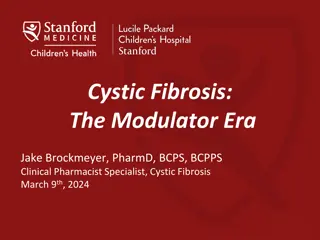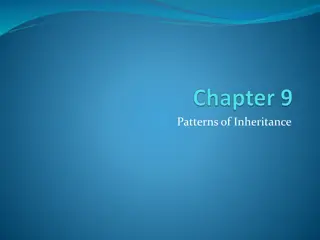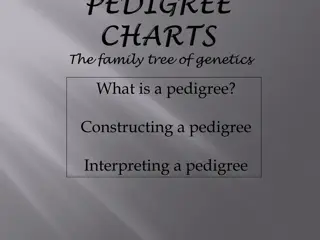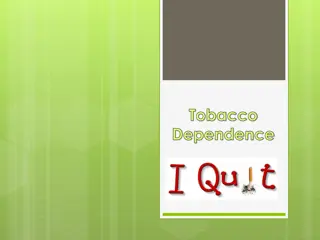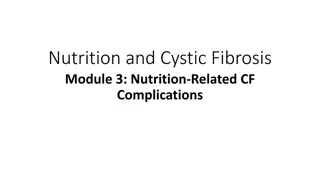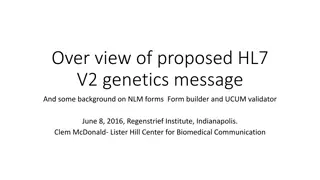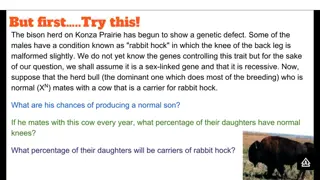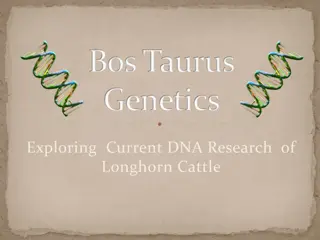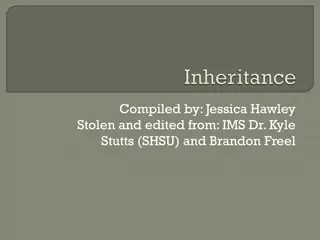Understanding Genetics: Part 2 - Cystic Fibrosis, Family Pedigrees, and Sex-Linked Genetic Disorders
Genetics is a fascinating field that influences our health and traits. Part 2 of our guide explores topics such as cystic fibrosis, family pedigrees, and sex-linked genetic disorders. Learn about the inheritance patterns, carrier statuses, and implications of these genetic conditions through detailed explanations and illustrative examples.
Download Presentation

Please find below an Image/Link to download the presentation.
The content on the website is provided AS IS for your information and personal use only. It may not be sold, licensed, or shared on other websites without obtaining consent from the author. Download presentation by click this link. If you encounter any issues during the download, it is possible that the publisher has removed the file from their server.
E N D
Presentation Transcript
EB Education Revision Guide EB Education Revision Guide How to work with Genetics: Part 2
Genetic Diseases Genetic Diseases Cystic Fibrosis Cystic fibrosis is a genetic disease which is caused by a recessive allele (represented by f). It creates a thick, sticky mucus and mainly affects the lungs and pancreas. Someone who is homozygous recessive (ff) for the disease will develop cystic fibrosis and suffer symptoms of this disease. Someone who is homozygous dominant (FF) or heterozygous (Ff) will not develop cystic fibrosis. This means that in order to inherit the disease, the child must inherit a recessive allele from both parents. People who are heterozygous (Ff) are known as carriers this is because they carry the recessive allele and can pass it on, but do not develop the disease. The Punnett square below shows that if both parents are heterozygous, and therefore carriers for cystic fibrosis, there is: 25% chance of a child having cystic fibrosis 50% chance of a child being a carrier 25% chance of a child being unaffected and not a carrier mother s genotype F f F FF Ff f Ff ff offspring s genotypes are in the middle father s genotype
Family Pedigrees Family Pedigrees What is it? Example 1: A family pedigree diagram can be used to demonstrate how alleles are passed through generations of a family. Horizontal lines link parents to each other and vertical lines link parents to their children. Females are represented with circles and males with squares. You can use the key to identify who is affected and who is not.
Family Pedigrees Family Pedigrees What is it? Example 2: This example shows a family pedigree for a family with members who are carriers of cystic fibrosis. Unaffected male Unaffected female This chart shows that cystic fibrosis is a recessive disorder as individuals can carry the allele but do not have the disorder. Affected male Affected female Male carrier ? The chances of this child having cystic fibrosis will be 25%, as both parents are carriers of the allele, and are therefore heterozygous (Ff). Possible genotypes of the offspring are FF, Ff, Ff, ff. Female carrier
Sex Sex- -Linked Genetic Disorders Linked Genetic Disorders What are they? Males are more likely to inherit some genetic disorders. These are known as sex-linked disorders. If an allele coding for a characteristic is found on a sex chromosome (X or Y), it is sex-linked. Most genes on the sex chromosomes are found on the X-chromosome, because the Y chromosome is much smaller, and so does not have as many genes. As the genotype of men is XY they only have one X chromosome. This means they often only have one allele (on the one X chromosome) for sex-linked genes. This makes it more likely for males to express this characteristic if it is recessive. Gene that men have only one allele for Female Male Gene that men have two alleles for
Sex Sex- -Linked Genetic Disorders Linked Genetic Disorders Diagram Colour blindness A faulty allele found on the X chromosome causes colour blindness. The Y chromosome does not have an allele for colour vision. 25% of the offspring will be colour blind, a 3: 1 ratio. These will all be male. When completing a Punnett square for sex-linked disorders, both the chromosome and the allele are included. X and Y represent the chromosomes, N is the normal colour vision allele, n is the faulty colour vision allele. Unaffected female carrier XN = X chromosome with normal allele Xn = X chromosome with faulty allele XN Xn XN XNXN XNXn Haemophilia is also a sex-linked disorder. This is a disease where blood does not clot properly, so sufferers of the disorder bleed for longer than usual if they cut themselves. XNY XnY Y Offspring s genotypes Unaffected male
Blood Groups Blood Groups How do you inherit them? Mother s genotype: Heterozygous Blood group A Multiple alleles determine which blood group you inherit. There are four different blood types in humans: O A B AB There are three different alleles for the gene determining blood type. IO IA IB IA and IB are what is known as co-dominant. This means that neither of these alleles are dominant over the other. If a person has the genotype IAIB they will express both alleles, and have the blood group AB. IO is a recessive allele. This means that to get blood type O you need to have two recessive alleles, IOIO. IAIO this means you will be blood group A, as A is dominant over O. IBIO this means you will be blood group B, as B is dominant over O. IA IO IB IAIB IBIO IO IAIO IOIO Father s genotype: Heterozygous Blood group B There is a 25% chance of a child having any of the four blood groups
Your turn: Your turn: b) Complete the Punnett square below for two heterozygous parents. 1. The diagram below shows how it can be inherited. Huntington s disease is an inherited disease. Father Mother h = normal H = Huntington s hh Hh H h h h Hh hh Hh hh c) Using the Punnett square calculate the probability of the offspring of these parents developing Huntington s disease. a) Huntington s disease is caused by a allele. Individuals suffering from Huntington s disease can have the HH or Complete the following sentences. .
Your turn: Your turn: d) Cystic fibrosis is also an inherited disorder. The diagram below shows how it is inherited. 2. The family pedigree diagram below shows the inheritance of cystic fibrosis in a family. Cystic fibrosis is caused by recessive alleles. f = cystic fibrosis F = normal Ff Ff Unaffected female Affected female Unaffected male F f F f Affected male Ff ff FF Ff 2 3 1 4 5 6 cystic fibrosis carrier normal carrier How many offspring in the 3rd generation have cystic fibrosis? Even though both sets of parents are heterozygous, explain why the chance of inheriting Huntington s disease is greater than the chance of inheriting cystic fibrosis. a)
Your turn: Your turn: b) Which of the below is the correct description for individual 3 in the 3rd generation c) Complete the Punnett square below to show the inheritance of cystic fibrosis in the 3rd generation. i) ii) iii) iv) Heterozygous for cystic fibrosis A carrier of the cystic fibrosis allele Homozygous recessive for cystic fibrosis Homozygous dominant for cystic fibrosis c) Explain how offspring in the 3rd generation can inherit cystic fibrosis when their parents and grandparents do not suffer from the disorder. d) Explain why unaffected individuals in the 3rd generation would find a pedigree analysis useful. ....................................
Your turn: Your turn: Haemophilia is an inherited sex-linked disorder, cause by a recessive allele. The inheritance of haemophilia is shown in the family pedigree diagram below.
Answers: Answers: b) Complete the Punnett square below for two heterozygous parents. 1. The diagram below shows how it can be inherited. Huntington s disease is an inherited disease. Father Mother h = normal H = Huntington s hh Hh H h HH Hh H H h h h h hh Hh Hh hh Hh hh c) Using the Punnett square calculate the probability of the offspring of these parents developing Huntington s disease. a) Huntington s disease is caused by a allele. Individuals suffering from Huntington s disease can have the HH or genotype Hh Complete the following sentences. dominant . 75% chance
Answers: Answers: d) Cystic fibrosis is also an inherited disorder. The diagram below shows how it is inherited. 2. The family pedigree diagram below shows the inheritance of cystic fibrosis in a family. Cystic fibrosis is caused by recessive alleles. f = cystic fibrosis F = normal Ff Ff Unaffected female Affected female Unaffected male F f F f Affected male Ff ff FF Ff 2 3 1 4 5 6 cystic fibrosis carrier normal carrier How many offspring in the 3rd generation have cystic fibrosis? Two Even though both sets of parents are heterozygous, explain why the chance of inheriting Huntington s disease is greater than the chance of inheriting cystic fibrosis. have Huntington s, whereas 2 alleles need to be inherited to get CF a) Huntington s is caused by a dominant allele, and cystic fibrosis by a recessive allele, therefore only 1 allele needs to be inherited to
Answers: Answers: b) Which of the below is the correct description for individual 3 in the 3rd generation c) Complete the Punnett square below to show the inheritance of cystic fibrosis in the 3rd generation. i) ii) iii) iv) Heterozygous for cystic fibrosis A carrier of the cystic fibrosis allele Homozygous recessive for cystic fibrosis Homozygous dominant for cystic fibrosis f F FF Ff F Ff ff f c) Explain how offspring in the 3rd generation can inherit cystic fibrosis when their parents and grandparents do not suffer from the disorder. recessive. d) Explain why unaffected individuals in the 3rd generation would find a pedigree analysis useful. .................................... chance they will pass on the gene. If both are heterozygous there is a 25% chance of offspring inheriting two recessive alleles. Both parents in the 2nd generation must carry the recessive allele and be carriers. The offspring in the 3rd generation who inherit cystic fibrosis must have inherited a recessive allele from each parent to be homozygous It can determine how likely it is that their offspring could inherit the CF allele. If they are carriers (heterozygous) there is a 50%
For more help and resources, or For more help and resources, or to work with us as a tutor, please to work with us as a tutor, please contact us contact us www.ebeducationservices.co.uk contact@ebeducationservices.co.uk 0161 442 5270



